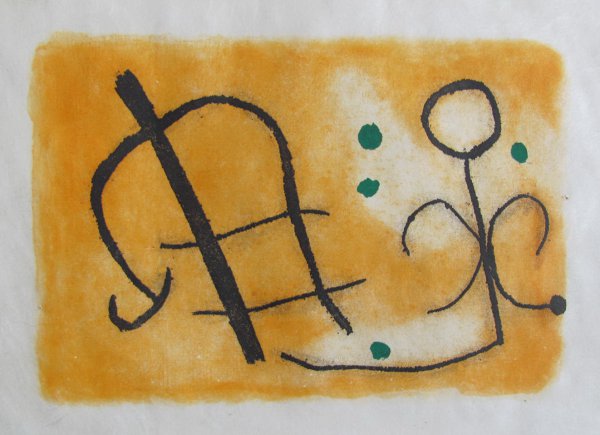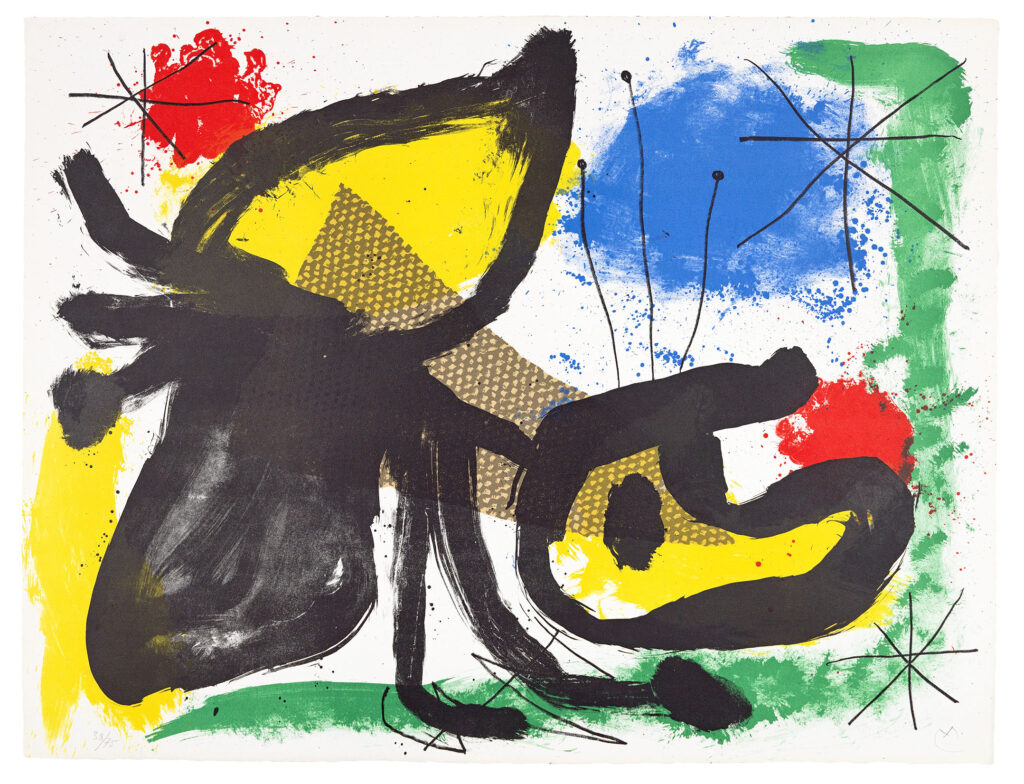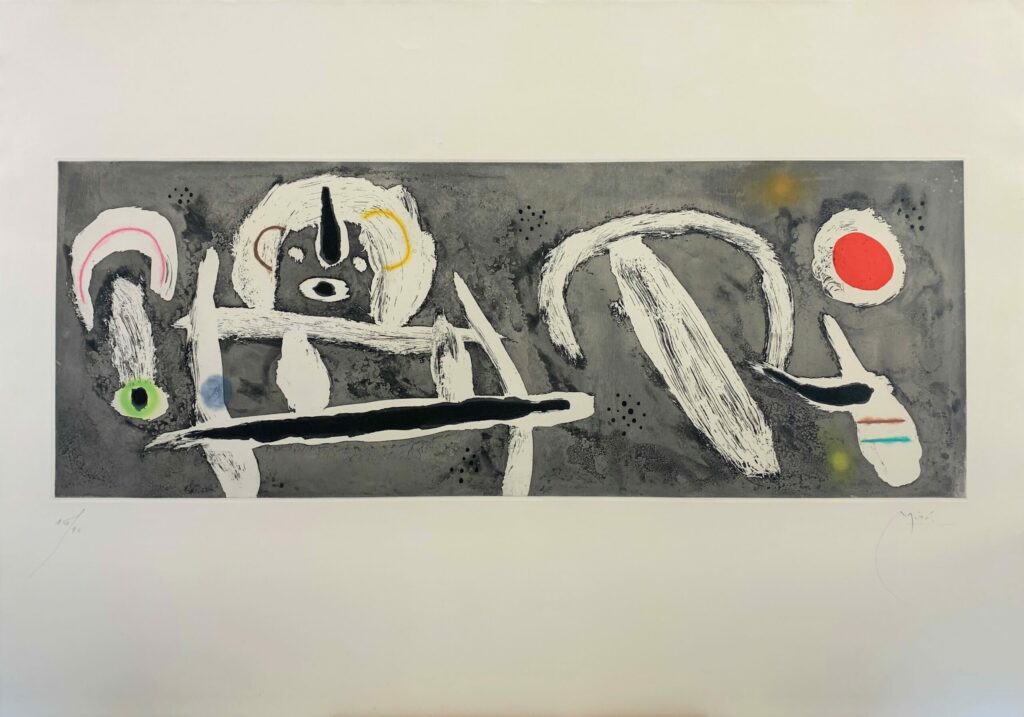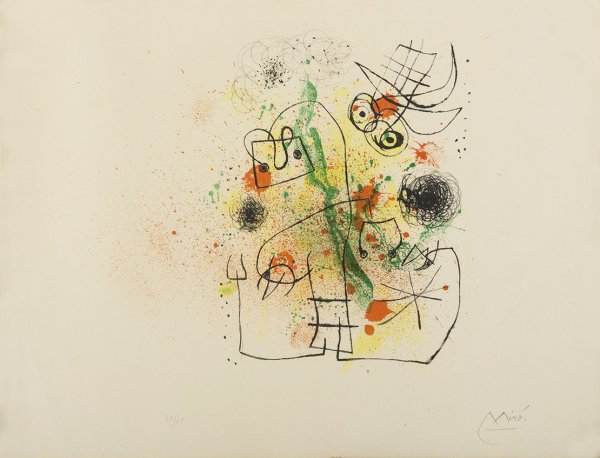Joan Miró Prints – Learning & Teaching
Joan Miró prints are very distinctive and instantaneously recognisable. Miró had a steadfast dedication to printmaking, just like his countryman and peer Pablo Picasso. He also produced more than 2,000 pieces in the medium, just like Picasso. It is frequently claimed that Miró’s preference for calligraphic lines, which are such a distinguishing aspect of his paintings, naturally suited itself to graphic work.
Miró was born in Barcelona in 1893, the son of a watchmaker. Early in the 1920s, he relocated to Paris and immediately joined the Surrealist movement. Additionally, he made friends with a number of avant-garde authors, including Paul Eluard, Max Jacob, Tristan Tzara, Antonin Artaud, and André Breton.

The first prints Miró ever created were drawings for L’arbre des Voyageurs, a 1930 collection of poems by Tzara. His inspiration from literature would come from a variety of sources, with famous examples including the play Ubu Roi by Alfred Jarry, the poem Fraternity by Stephen Spender, and the mystic, mediaeval work Canticle of the Sun by St. Francis of Assisi.
Three major categories can be used to classify Miró’s prints. lithography, carborundum, and intaglio (drypoint and etching).
Joan Miró prints can be broadly divided into three groups which are essentially the three main techniques he employed: intaglio (i.e., drypoint and etching), lithograph, and carborundum.
He established tight working relationships with the heads of reputable printing ateliers in each instance. The first of these was the great intaglio printer Roger Lacourière, who also created the Vollard Suite print series by Picasso.

The 1933 drypoint Daphnis & Chloé, in which a goatherd playing a reed pipe charms two girl swimmers from the sea, was one of Miró’s achievements with Lacourière. As delicate and lyrical as the music being performed are Miró’s lines.
In Paris and then in New York, he collaborated with Stanley William Hayter, another important printer (where the latter moved at the start of the Second World War).
In addition to developing the simultaneous colour printmaking technique known as “viscosity printing,” Hayter is recognised for his intaglio experimentation. This involved the then-unusual technique of applying multiple colours to a single plate, which produced etchings like Serie II (above).

Picasso’s and Miró’s approaches to the medium can be clearly contrasted. The former was generally content to work within the lengthy, well-established tradition of European printmaking, whilst the later was happiest when violating the norms and taking an unconventional route. (Picasso, for instance, was known to add suet and nail polish to his prints in an effort to create unusual effects.)
Miró had too much regard for his supplies and instruments to use them according to his own plans; instead, he beckoned them. He engaged them in passionate conversation,” the critic Jacques Dupin wrote about the artist in his book.
He also had a talent for listening to [people like Lacourière and Hayter], allowing them the chance to collaborate with him in the true spirit of group solidarity… He thrived on the camaraderie of group projects.
The connection between Miró and Fernand Mourlot, a printer, lasted from 1947 until the 1970s and produced several of his best lithographs, including the aforementioned Suites pour Ubu Roi.

The majority of the prints created in Mourlot’s workshop were vividly coloured. The “Barcelona Series,” nevertheless, which is regarded as Miró’s finest lithographic work, was produced in black and white.
It represented the artist’s response to the Spanish Civil War and consisted of 50 images created between 1939 and 1944. He shows his disdain for the conflict that had decimated his country by including a variety of bizarre characters with sharp-tipped tongues, arms like hooks, and noses like elephant trunks.
The carborundum prints that Miró started producing in the late 1960s are what Macaulay refers to as “the climax and final development of his graphic work.”
They involved an engraving technique in which a binding agent was combined with the abrasive grind known as carborundum (or silicon carbide, to give it its official name). The finished prints frequently had a rich, velvety, granular surface that, created a striking visual equivalent to the rich surface texture of his paintings.
Joan Miró Print
View available Joan Miró prints here.
